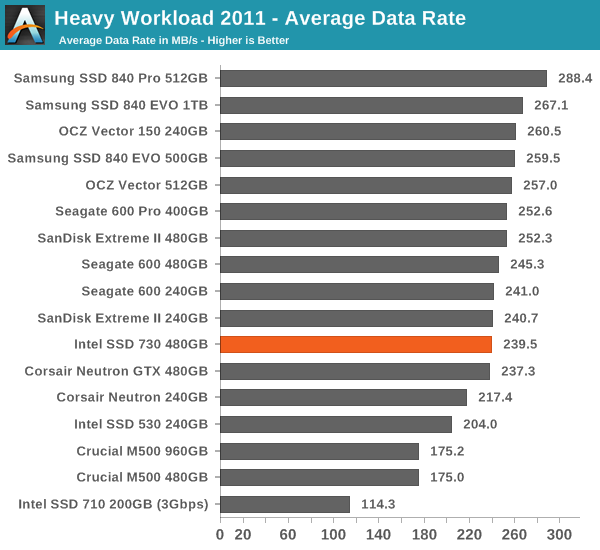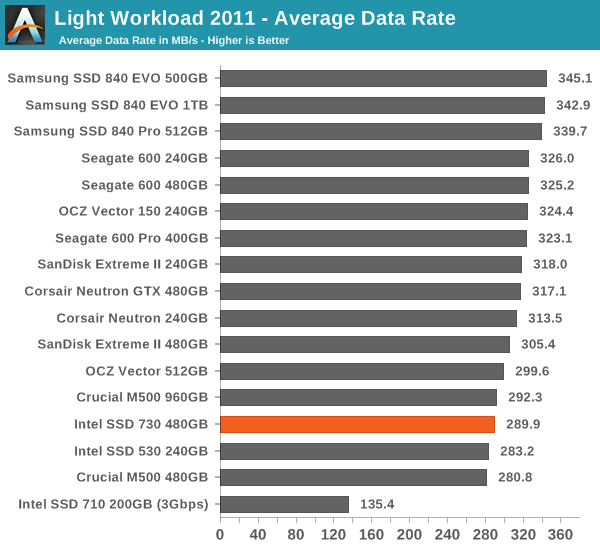Intel SSD 730 (480GB) Review: Bringing Enterprise to the Consumers
by Kristian Vättö on February 27, 2014 12:00 PM EST- Posted in
- Storage
- SSDs
- Intel
- Intel SSD 730
AnandTech Storage Bench 2011
Back in 2011 (which seems like so long ago now!), we introduced our AnandTech Storage Bench, a suite of benchmarks that took traces of real OS/application usage and played them back in a repeatable manner. The MOASB, officially called AnandTech Storage Bench 2011 - Heavy Workload, mainly focuses on peak IO performance and basic garbage collection routines. There is a lot of downloading and application installing that happens during the course of this test. Our thinking was that it's during application installs, file copies, downloading and multitasking with all of this that you can really notice performance differences between drives.
We tried to cover as many bases as possible with the software incorporated into this test. There's a lot of photo editing in Photoshop, HTML editing in Dreamweaver, web browsing, game playing/level loading (Starcraft II & WoW are both a part of the test) as well as general use stuff (application installing, virus scanning). We've included a large amount of email downloading, document creation and editing as well. To top it all off we even use Visual Studio 2008 to build Chromium during the test.
The test has 2,168,893 read operations and 1,783,447 write operations. The IO breakdown is as follows:
| AnandTech Storage Bench 2011 - Heavy Workload IO Breakdown | ||||
| IO Size | % of Total | |||
| 4KB | 28% | |||
| 16KB | 10% | |||
| 32KB | 10% | |||
| 64KB | 4% | |||
Only 42% of all operations are sequential, the rest range from pseudo to fully random (with most falling in the pseudo-random category). Average queue depth is 4.625 IOs, with 59% of operations taking place in an IO queue of 1. The full description of the test can be found here.
AnandTech Storage Bench 2011 - Heavy Workload

AnandTech Storage Bench 2011 - Light Workload
Our light workload actually has more write operations than read operations. The split is as follows: 372,630 reads and 459,709 writes. The relatively close read/write ratio does better mimic a typical light workload (although even lighter workloads would be far more read centric). There's lots of web browsing, photo editing (but with a greater focus on photo consumption), video playback as well as some application installs and gaming.
The I/O breakdown is similar to the heavy workload at small IOs, however you'll notice that there are far fewer large IO transfers.
| AnandTech Storage Bench 2011 - Light Workload IO Breakdown | ||||
| IO Size | % of Total | |||
| 4KB | 27% | |||
| 16KB | 8% | |||
| 32KB | 6% | |||
| 64KB | 5% | |||

Again, the SSD 730 comes up with relatively uninspiring performance in this lighter, older workload. If your usage patterns are relatively tame, a drive designed for enterprise usage scenarios may be more than you need and may actually end up performing slower than "lesser" drives in day-to-day use—not that you'd likely notice, as most decent SSDs are now at the point where to normal users they're all plenty fast.










96 Comments
View All Comments
CrazyElf - Thursday, February 27, 2014 - link
Seeing that the SSD market is a low margin market, I get the feeling that Intel's strategy is to use it's existing reputation as a "reliable" vendor of SSD solutions and milk it so to speak. So that means little competition from a serious price to performance stand point, and more focus on product margins.NCM - Thursday, February 27, 2014 - link
I've reread the first page about 5 times and I still can't tell what controller is in this drive. There's reference to previous use of SF, but no indication of what's now in use.Did that info end up on the editing room floor?
Death666Angel - Thursday, February 27, 2014 - link
From the text "Adopting the platform from the DC S3500/S3700", "The controller is the same 8-channel design as in the S3500/S3700 but runs at 600MHz instead of the 400MHz of the S3500/S3700.". From the table "Controller Intel 3rd Generation (SATA 6Gbps)".NCM - Friday, February 28, 2014 - link
@Death666Angel (!) Thanks for the controller parsing. A rather convoluted way for readers to arrive at an answer, but we get there in the end.In a related matter the reviewer writes: "We use both standard pseudo randomly generated data for each write as well as fully random data to show you both the maximum and minimum performance offered by SandForce based drives in these tests. The average performance of SF drives will likely be somewhere in between the two values for each drive you see in the graphs."
However in none of the tables are the Sandforce drives identified. Apparently we're supposed to have memorized beforehand what controllers each drive uses. This is not some a mere quibble on my part. We have a couple of dozen workstations using SSD's, and because we work with a lot of incompressible data I do not buy drives with SF controllers.
Please AnandTech: if you're going to bother making technical distinctions of this kind, make it clear where they apply.
Mr Perfect - Friday, February 28, 2014 - link
That's strange, they used to label the drives in the charts with what controller was in them.Kristian Vättö - Saturday, March 1, 2014 - link
The controller is also listed in the table, although it's just "Intel 3rd gen" as to my knowledge it doesn't have any specific codename.As for the other feedback, the part you quoted it just a boilerplate that was we use in every review but I see that there's a need to update it.
Mipmap - Thursday, February 27, 2014 - link
"to invest in custom client-orientated silicon." oriented"There wasn't much competition and given Intel's resourced" resources
Death666Angel - Thursday, February 27, 2014 - link
Orientated/oriented is a preference thing. Neither option is wrong.CalaverasGrande - Thursday, February 27, 2014 - link
the meaning is conveyed either way, but I have always taken orientated in the same way I take "moneys'. While I understand the intent, it still sounds awkward and uneducated.redmist77 - Thursday, February 27, 2014 - link
Saying 'orientated' is as dumb as saying 'documentated' or 'adaptated.'